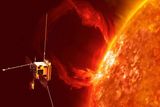Organic LED can electrically switch the handedness of emitted light
Circularly polarized (CP) light is encoded with information through its photon spin and can be utilized in applications such as low-power displays, encrypted communications and quantum technologies. Organic light emitting diodes (OLEDs) produce CP light with a left or right “handedness”, depending on the chirality of the light-emitting molecules used to create the device.
While OLEDs usually only emit either left- or right-handed CP light, researchers have now developed OLEDs that can electrically switch between emitting left- or right-handed CP light – without needing different molecules for each handedness.
“We had recently identified an alternative mechanism for the emission of circularly polarized light in OLEDs, using our chiral polymer materials, which we called anomalous circularly polarized electroluminescence,” says lead author Matthew Fuchter from the University of Oxford. “We set about trying to better understand the interplay between this new mechanism and the generally established mechanism for circularly polarized emission in the same chiral materials”.
Light handedness controlled by molecular chirality
The CP light handedness of an organic emissive molecule is controlled by its chirality. A chiral molecule is one that has two mirror-image structural isomers that can’t be superimposed on top of each other. Each of these non-superimposable molecules is called an enantiomer, and will absorb, emit and refract CP light with a defined spin angular momentum. Each enantiomer will produce CP light with a different handedness, through an optical mechanism called normal circularly polarized electroluminescence (NCPE).
OLED designs typically require access to both enantiomers, but most chemical synthesis processes will produce racemic mixtures (equal amounts of the two enantiomers) that are difficult to separate. Extracting each enantiomer so that they can be used individually is complex and expensive, but the research at Oxford has simplified this process by using a molecule that can switch between emitting left- and right-handed CP light.
The molecule in question is a helical molecule called (P)-aza[6]helicene, which is the right-handed enantiomer. Even though it is just a one-handed form, the researchers found a way to control the handedness of the OLED, enabling it to switch between both forms.
Switching handedness without changing the structure
The researchers designed the helicene molecules so that the handedness of the light could be switched electrically, without needing to change the structure of the material itself. “Our work shows that either handedness can be accessed from a single-handed chiral material without changing the composition or thickness of the emissive layer,” says Fuchter. “From a practical standpoint, this approach could have advantages in future circularly polarized OLED technologies.”
Instead of making a structural change, the researchers changed the way that the electric charges are recombined in the device, using interlayers to alter the recombination position and charge carrier mobility inside the device. Depending on where the recombination zone is located, this leads to situations where there is balanced or unbalanced charge transport, which then leads to different handedness of CP light in the device.
When the recombination zone is located in the centre of the emissive layer, the charge transport is balanced, which generates an NCPE mechanism. In these situations, the helicene adopts its normal handedness (right handedness).
However, when the recombination zone is located close to one of the transport layers, it creates an unbalanced charge transport mechanism called anomalous circularly polarized electroluminescence (ACPE). The ACPE overrides the NCPE mechanism and inverts the handedness of the device to left handedness by altering the balance of induced orbital angular momentum in electrons versus holes. The presence of these two electroluminescence mechanisms in the device enables it to be controlled electrically by tuning the charge carrier mobility and the recombination zone position.
The research allows the creation of OLEDs with controllable spin angular momentum information using a single emissive enantiomer, while probing the fundamental physics of chiral optoelectronics. “This work contributes to the growing body of evidence suggesting further rich physics at the intersection of chirality, charge and spin. We have many ongoing projects to try and understand and exploit such interplay,” Fuchter concludes.
The researchers describe their findings in Nature Photonics.
The post Organic LED can electrically switch the handedness of emitted light appeared first on Physics World.












